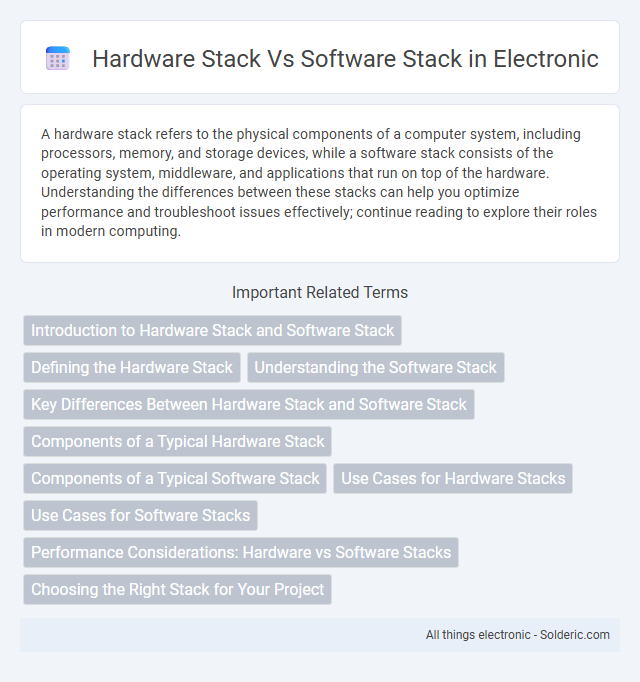A hardware stack refers to the physical components of a computer system, including processors, memory, and storage devices, while a software stack consists of the operating system, middleware, and applications that run on top of the hardware. Understanding the differences between these stacks can help you optimize performance and troubleshoot issues effectively; continue reading to explore their roles in modern computing.
Comparison Table
| Aspect | Hardware Stack | Software Stack |
|---|---|---|
| Definition | Physical components of a computer system | Programs and applications operating on hardware |
| Components | CPU, RAM, Motherboard, Storage, GPU | Operating System, Middleware, Application Software, APIs |
| Purpose | Provide computing resources and processing power | Enable functionality and user interaction with hardware |
| Upgradability | Physical replacement or addition required | Software updates and patches via downloads |
| Dependency | Required for software to run | Depends on specific hardware compatibility |
| Examples | Intel i7 CPU, Samsung SSD, Nvidia GPU | Windows OS, Apache Server, Microsoft Office |
Introduction to Hardware Stack and Software Stack
Hardware stack refers to the physical components of a computing system, including processors, memory devices, storage units, and network interfaces that form the foundation for all computing tasks. Software stack consists of operating systems, middleware, and applications that run on the hardware and enable users to perform specific functions. Understanding the distinction between your hardware stack and software stack is crucial for optimizing system performance, compatibility, and scalability.
Defining the Hardware Stack
The hardware stack refers to the layered physical components of a computer system, including the processor, memory modules, storage devices, and input/output interfaces. It forms the foundation on which the software stack operates, enabling the execution of applications and operating systems by providing essential computational resources. Key hardware elements like CPUs, GPUs, RAM, and motherboard architecture determine the performance and capabilities of the overall system.
Understanding the Software Stack
The software stack consists of various layers, including the operating system, middleware, runtime environments, and applications, that work together to enable your computer to perform specific tasks. Understanding the software stack helps you optimize performance and troubleshoot issues by identifying how each layer interacts with the underlying hardware stack. Mastery of these components allows you to develop, deploy, and maintain efficient software solutions tailored to specific hardware capabilities.
Key Differences Between Hardware Stack and Software Stack
The hardware stack consists of physical components such as processors, memory, and input/output devices that form the infrastructure of computing systems, while the software stack includes operating systems, middleware, and applications that manage and utilize the hardware resources. Hardware stacks are static and tangible, requiring physical installation and upgrades, whereas software stacks are dynamic, allowing frequent updates and patches to improve performance and security. The interaction between the two stacks is crucial for system functionality, with software stacks abstracting hardware complexities and enabling user-level operations.
Components of a Typical Hardware Stack
A typical hardware stack consists of multiple layers including the physical components such as processors, memory modules, storage devices, and network interfaces, which form the foundation for computing tasks. These elements work together to provide the necessary resources that support the software stack, ensuring efficient data processing and communication. Understanding your hardware stack components can help optimize system performance and compatibility with software applications.
Components of a Typical Software Stack
A typical software stack includes layers such as the operating system, middleware, runtime environments, and application software that work together to provide a seamless user experience. Key components often comprise the web server, database management system, programming languages, and libraries or frameworks essential for application development. This stack contrasts with the hardware stack, which involves physical devices like CPUs, memory modules, storage drives, and network interfaces that support software execution.
Use Cases for Hardware Stacks
Hardware stacks are essential in applications requiring low latency and high-performance processing, such as real-time embedded systems, telecommunications, and industrial automation. They provide robust support for tasks involving direct control of physical devices, sensor data acquisition, and signal processing. Common use cases include FPGA-based designs, ASIC implementations, and IoT edge devices where hardware acceleration delivers critical speed and efficiency advantages.
Use Cases for Software Stacks
Software stacks enable rapid application development and deployment across various industries, including web development, mobile apps, and cloud computing. They provide essential frameworks, libraries, and middleware that streamline coding, testing, and scalability for platforms like MEAN, LAMP, and MERN. Enterprises leverage software stacks to reduce time-to-market, enhance integration, and ensure consistent performance within diverse IT environments.
Performance Considerations: Hardware vs Software Stacks
Hardware stacks provide superior performance by executing tasks at the physical circuit level, minimizing latency and maximizing processing speed for critical computations. Software stacks, while more flexible and easier to update, incur overhead from abstraction layers that can slow execution and increase resource consumption. Optimizing Your system's performance requires balancing the raw efficiency of hardware stacks with the adaptability of software stacks based on specific application demands.
Choosing the Right Stack for Your Project
Choosing the right stack for your project involves understanding the distinct roles of hardware and software stacks in delivering optimal performance and functionality. Hardware stacks encompass physical components like processors, memory, and storage, which provide the foundational infrastructure, while software stacks include operating systems, middleware, and applications that enable your project's functionality. Prioritizing compatibility and scalability between these stacks ensures your solution meets project requirements efficiently and supports future growth.
Hardware stack vs software stack Infographic

 solderic.com
solderic.com